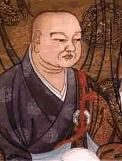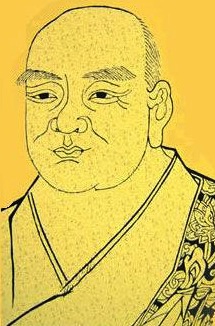Related Research Articles

Bodhidharma was a semi-legendary Buddhist monk who lived during the 5th or 6th century CE. He is traditionally credited as the transmitter of Chan Buddhism to China, and is regarded as its first Chinese patriarch. According to a 17th-century apocryphal story found in a manual called Yijin Jing, he began the physical training of the monks of Shaolin Monastery that led to the creation of Shaolin kungfu. He is known as Dámó in China and as Daruma in Japan. His name means "dharma of awakening (bodhi)" in Sanskrit.

Greco-Buddhism or Graeco-Buddhism denotes a supposed cultural syncretism between Hellenistic culture and Buddhism developed between the 4th century BC and the 5th century AD in Gandhara, in present-day Pakistan and parts of north-east Afghanistan. While the Greco-Buddhist art shows clear Hellenistic influences, the majority of scholars do not assume a noticeable Greek influence on Gandharan Buddhism beyond the artistic realm.

Daisetsu Teitaro Suzuki, self-rendered in 1894 as "Daisetz", was a Japanese essayist, philosopher, religious scholar, translator, and writer. He was a scholar and author of books and essays on Buddhism, Zen and Shin that were instrumental in spreading interest in both Zen and Shin to the West. Suzuki was also a prolific translator of Chinese, Korean, Japanese, Vietnamese and Sanskrit literature. Suzuki spent several lengthy stretches teaching or lecturing at Western universities, and devoted many years to a professorship at Ōtani University, a Japanese Buddhist school.

A lineage in Buddhism is a line of transmission of the Buddhist teaching that is "theoretically traced back to the Buddha himself." The acknowledgement of the transmission can be oral, or certified in documents. Several branches of Buddhism, including Chan and Tibetan Buddhism maintain records of their historical teachers. These records serve as a validation for the living exponents of the tradition.

Dazu Huike is considered the Second Patriarch of Chan Buddhism and the twenty-ninth since Gautama Buddha. He was the successor to Bodhidharma.
During the reign of Emperor Wu of the Liang dynasty, he embraced and promoted Buddhism. Several times he became a Buddhist monk and forced his court to purchase him back with substantial offerings to the sangha. In 517 he ordered the destruction of Taoist temples and forced Taoist priests to return to lay life. Some of his other reforms, such as the disallowing of capital punishment and of the animal sacrifices during ancestral ceremonies, conformed with his Buddhist convictions.

Keizan Jōkin, also known as Taiso Jōsai Daishi, is considered to be the second great founder of the Sōtō school of Zen in Japan. While Dōgen, as founder of Japanese Sōtō, is known as Highest Ancestor, Keizan is often referred to as Great Ancestor.

The ten principal disciples were the main disciples of Gautama Buddha. Depending on the scripture, the disciples included in this group vary. In many Mahāyāna discourses, these ten disciples are mentioned, but in differing order. The ten disciples can be found as an iconographic group in notable places in the Mogao Caves. They are mentioned in Chinese texts from the fourth century BCE until the twelfth century CE, and are the most honored of the groups of disciples, especially so in China and Central Asia. The ten disciples are mentioned in the Mahāyāna text Vimalakīrti-nideśa, among others. In this text, they are called the "Ten Wise Ones", a term which is normally used for the disciples of Confucius.

Heze Shenhui was a Chinese Buddhist monk of the so-called "Southern School" of Zen, who "claimed to have studied under Huineng."
James Robson is James C. Kralik and Yunli Lou Professor of East Asian Languages and Civilizations at Harvard University and William Fung Director of the Harvard University Asia Center. Robson is the incoming director of the Harvard-Yenching Institute, succeeding Elizabeth J. Perry.

Urs App is a historian of ideas, religions, and philosophies with a special interest in the history and modes of interaction between East and West.

Zen is a school of Mahayana Buddhism that originated in China during the Tang dynasty as the Chan School or the Buddha-mind school, and later developed into various sub-schools and branches. From China, Chán spread south to Vietnam and became Vietnamese Thiền, northeast to Korea to become Seon Buddhism, and east to Japan, becoming Japanese Zen.
Fabio Rambelli is an Italian academic, author and editor. He is a professor in the Department of Religious Studies at the University of California, Santa Barbara (UCSB).

Chan, from Sanskrit dhyāna, is a Chinese school of Mahāyāna Buddhism. It developed in China from the 6th century CE onwards, becoming especially popular during the Tang and Song dynasties.
William Marvin Bodiford is an American professor and author. He teaches Buddhist Studies and religion in the cultures of Japan and East Asia at the University of California, Los Angeles.
Modern scientific research on the history of Zen discerns three main narratives concerning Zen, its history and its teachings: Traditional Zen Narrative (TZN), Buddhist Modernism (BM), Historical and Cultural Criticism (HCC). An external narrative is Nondualism, which claims Zen to be a token of a universal nondualist essence of religions.

Original enlightenment or innate awakening is an East Asian Buddhist doctrine often translated as "inherent", "innate", "intrinsic" or "original" awakeness.

Nanyue Huisi, was an eminent Chinese Buddhist monk, traditionally regarded as the third patriarch of the Tiantai school. According to Sasaki, Huisi "was the leading authority on the Lotus Sutra of his time."
Stephen F. Teiser is the D. T. Suzuki Professor in Buddhist Studies and Professor of Religion at Princeton University, where he is also the Director of the Program in East Asian Studies. His scholarship is known for a broad conception of Buddhist thinking and practice, showing the interactions between Buddhism in India, China, Korea and Japan, especially in the medieval period; for the use of wide-ranging sources, not only texts and documents, but artistic and material; for a theoretical approach that builds insights from history, anthropology, literary theory, and religious studies; and for seeing Buddhism in both elite and popular contexts.

Franciscus Verellen is a historian of medieval China specializing in the Tang-Song transition and the religious culture of Daoism in its formative period. He is Professor Emeritus and a former Director of the École française d’Extrême-Orient.
References
- ↑ "Department of Religion". religion.columbia.edu. Archived from the original on 2019-06-22. Retrieved 2015-12-29.
- ↑ Office, Publications. "UBEF Visiting Professor in Buddhist Studies". sydney.edu.au. Retrieved 2015-12-29.[ permanent dead link ]
- ↑ Office, Publications. "UBEF Visiting Professor in Buddhist Studies". sydney.edu.au. Retrieved 2015-12-29.[ permanent dead link ]
- ↑ Faure, Bernard (1999). "Conférence de M. Bernard Faure". Annuaires de l'École Pratique des Hautes Études. 112 (108): 137–145. Retrieved 2015-12-29.
- ↑ "Humanities & Sciences scholars honored with endowed professorships". news.stanford.edu. Retrieved 2015-12-29.
- ↑ "People | Center for Buddhism and East Asian Religions". blogs.cuit.columbia.edu. Archived from the original on 2015-10-15. Retrieved 2015-12-29.
- ↑ "Bernard Faure - EAST ASIAN LANGUAGES AND CULTURES". EAST ASIAN LANGUAGES AND CULTURES. Retrieved 2015-12-29.
- ↑ Office, Publications. "UBEF Visiting Professor in Buddhist Studies". sydney.edu.au. Retrieved 2015-12-29.[ permanent dead link ]
- ↑ "University of Hawaii Press - The Fluid Pantheon: Gods of Medieval Japan, Volume 1". www.uhpress.hawaii.edu. Archived from the original on 2016-04-09. Retrieved 2015-12-29.
- ↑ Faure, Bernard (2015-10-01). Gods of Medieval Japan. University of Hawaii Press. ISBN 9780824839338.
- ↑ "University of Hawaii Press - Protectors and Predators: Gods of Medieval Japan, Volume 2". www.uhpress.hawaii.edu. Archived from the original on 2016-03-04. Retrieved 2015-12-29.
- ↑ Faure, Bernard (2015-10-01). Gods of Medieval Japan. University of Hawaii Press. ISBN 9780824839338.
- ↑ Faure, Bernard (2011-09-13). Unmasking Buddhism. John Wiley & Sons. ISBN 9781444356618.
- ↑ Faure, Bernard (2008-01-01). Bouddhisme et violence (in French). Le Cavalier bleu. ISBN 9782846702294.
- ↑ Faure, Bernard (2009-01-10). The Power of Denial: Buddhism, Purity, and Gender. Princeton University Press. ISBN 978-1400825615.
- ↑ Faure, B.: The Power of Denial: Buddhism, Purity, and Gender. (eBook and Paperback). press.princeton.edu. 2003-03-02. ISBN 9780691091716 . Retrieved 2015-12-29.
- ↑ Heine, Steven (2006). "Reviewed work: Double Exposure: Cutting across Buddhist and Western Discourses, Bernard Faure". Philosophy East and West. 56 (1): 178–180. doi:10.1353/pew.2006.0011. JSTOR 4488007. S2CID 170656174.
- ↑ Faure, Bernard; Lloyd, Janet (2004-01-01). Double Exposure: Cutting Across Buddhist and Western Discourses. Stanford University Press. ISBN 9780804743488.
- ↑ Faure, Bernard (1998-10-26). The Red Thread: Buddhist Approaches to Sexuality. Princeton University Press. ISBN 1400822602.
- ↑ Guthrie, Elizabeth (2007). "Reviewed work: The Red Thread: Buddhist Approaches to Sexuality, Bernard Faure". Crossroads: An Interdisciplinary Journal of Southeast Asian Studies. 19 (1): 208–210. JSTOR 40860878.
- ↑ Faure, Bernard (1997-01-01). The Will to Orthodoxy: A Critical Genealogy of Northern Chan Buddhism. Stanford University Press. ISBN 9780804728652.
- ↑ Dippmann, Jeffrey (1999). "Reviewed work: The Will to Orthodoxy: A Critical Genealogy of Northern Chan Buddhism, Bernard Faure, Phyllis Brooks". Philosophy East and West. 49 (3): 386–388. doi:10.2307/1399903. JSTOR 1399903.
- ↑ Faure, Bernard (1993-01-01). Chan Insights and Oversights an Epistemological Critique of the Chan Tradition. Monograph Collection (Matt - Pseudo).
- ↑ Heine, Steven (1996). "Reviewed work: Visions of Power: Imagining Medieval Japanese Buddhism, Bernard Faure, Phyllis Brooks". Monumenta Nipponica. 51 (3): 383–386. doi:10.2307/2385619. JSTOR 2385619.
- ↑ Faure, Bernard (2000-01-01). Visions of Power: Imagining Medieval Japanese Buddhism. Princeton University Press. ISBN 0691029415.
- ↑ Faure, Bernard (1994-01-01). The Rhetoric of Immediacy: A Cultural Critique of Chan/Zen Buddhism. Princeton University Press. ISBN 0691029636.
- ↑ Faure, Bernard (1994-01-01). La mort dans les religions d'Asie: un exposé pour comprendre, un essai pour réfléchir (in French). Flammarion. ISBN 9782080352002.
- ↑ Faure, Bernard; Moerman, David Max; Sekimori, Gaynor (2011-01-01). Shugendo : l'histoire et la culture d'une religion japonaise. Ecole française d'Extrême-Orient. ISBN 9782855391236.
- ↑ Strickmann, Michel; Faure, Bernard (2005-01-01). Chinese Poetry and Prophecy: The Written Oracle in East Asia. Stanford University Press. ISBN 9780804743341.
- ↑ Strickmann, Michel; Faure, Bernard (2002-01-01). Chinese Magical Medicine. Stanford University Press. ISBN 9780804739405.
- ↑ Kieschnick, John; Shahar, Meir (2013-12-26). India in the Chinese Imagination: Myth, Religion, and Thought. University of Pennsylvania Press. ISBN 9780812245608.
- ↑ "A Gray Matter | Tricycle". tricycle.org. 30 November 2012. Retrieved 2016-09-22.
- ↑ Murphy, Andrew R. (2011-04-20). The Blackwell Companion to Religion and Violence. John Wiley & Sons. ISBN 9781444395730.
- ↑ Faure, Bernard (2011). "From Bodhidharma to Daruma: The Hidden Life of a Zen Patriarch". Japan Review (23): 45–71. JSTOR 41304923.
- ↑ "Bernard Faure | Columbia University - Academia.edu". columbia.academia.edu. Retrieved 2015-12-29.